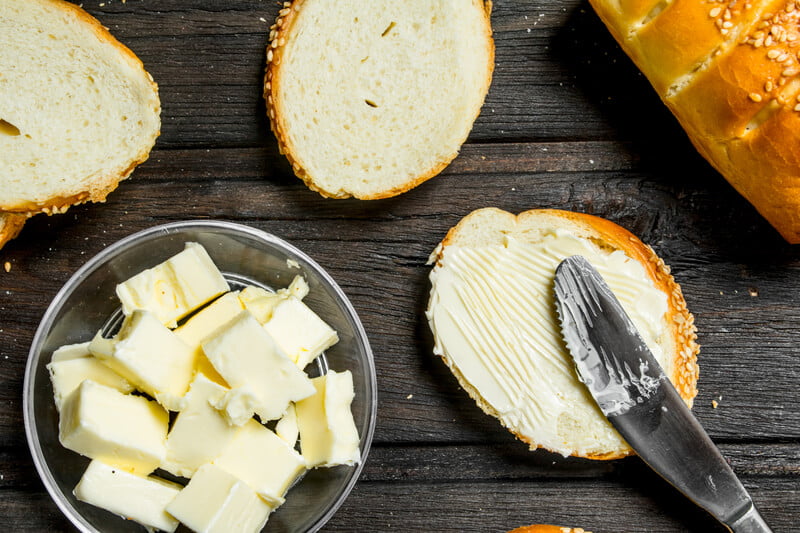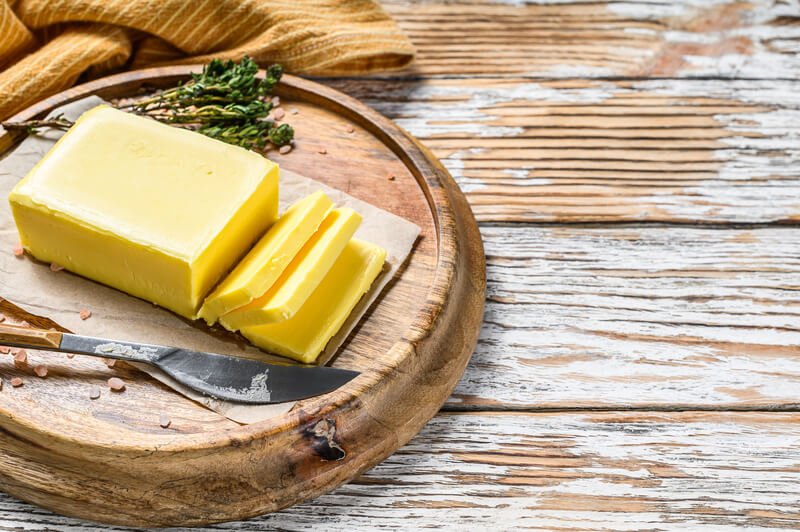Butter has been used for centuries for cooking, baking, and as a spread.
Butter does come from mammal milk. However, it contains so little lactose that it can be incorporated into a lactose-free diet. There are also some vegan butter variations available.
How Is Butter Made?
Butter is a solid food used for cooking and as a spread.
With a very high-fat content, it is usually made from cow’s milk, although you can also get goat, sheep, and even buffalo butter in some areas.
The process of making butter differs depending on whether it’s farm butter or commercially made butter.
Farm butter takes the cream from whole milk, churning or shaking it until it separates into two parts. The solid part, called butterfat, will be made into butter.
Commercially made butter uses centrifuges to extract small amounts of cream from whey, the watery part leftover after milk forms curds.

Does Butter Always Contain Milk?
Butter is always made from the milk of a mammal, most commonly the cow.
It has been created for centuries from mammal milk.
Nowadays, however, you can also find some non-animal butter products with the flavor and consistency of real animal butter.
While most butter does come from milk, those on dairy-free diets may still be able to enjoy it.
This is because its properties are fairly different from most dairy products, which we’ll discuss further below.
Related: Does Mayo Have Milk In It?
Is There Vegan Butter?
If you’re not fond of animal products and prefer non-dairy milk alternatives, there are vegan and vegetarian butter options for you.
Vegan butter is made by combining water with plant-sourced oil. Some oils used are avocado, olive, palm kernel, or coconut.
Plant-based butter has more monounsaturated fats, less saturated fat, and is overall better for the environment.
Not sure which vegan butter to try?
Sarah's Vegan Kitchen tried several of the most popular vegan butter brands, including a baking test!
Is Butter a Dairy Product?
Dairy includes any products made from or including milk. Since butter comes directly from a milk source, it’s considered dairy; however, strangely enough, most butter is allowed in dairy-free diets.
How could this be?
Generally, people who look for dairy-free products either have an allergy or are lactose-intolerant.
Those with allergies have a problem digesting the protein in milk, while lactose-intolerant people cannot digest milk's main carbohydrate (lactose).
Unlike most other dairy items, butter has extremely low amounts of lactose and protein.
Most people on a lactose-free diet can enjoy butter without issue.
Those with an allergy should still be wary of butter, even if it has trace amounts of protein.
Animal butter is also off-limits for vegans.

Final Thoughts
Butter has long been sourced from cow’s milk, among other mammals. After separating the fat from the liquid of the milk’s cream, you’re left with the solid that becomes butter.
Even though it comes from milk, butter contains such little lactose that most lactose-free individuals can eat it. While it shouldn’t spark a reaction, it’s best to play it safe and avoid it altogether if you have a milk allergy.
